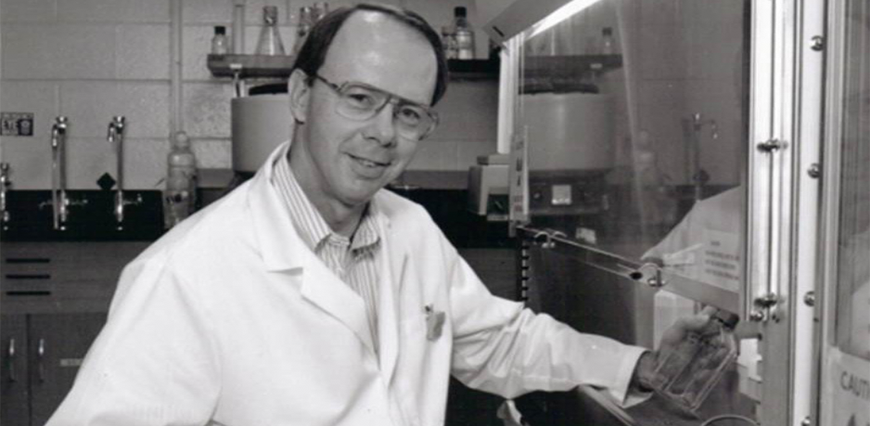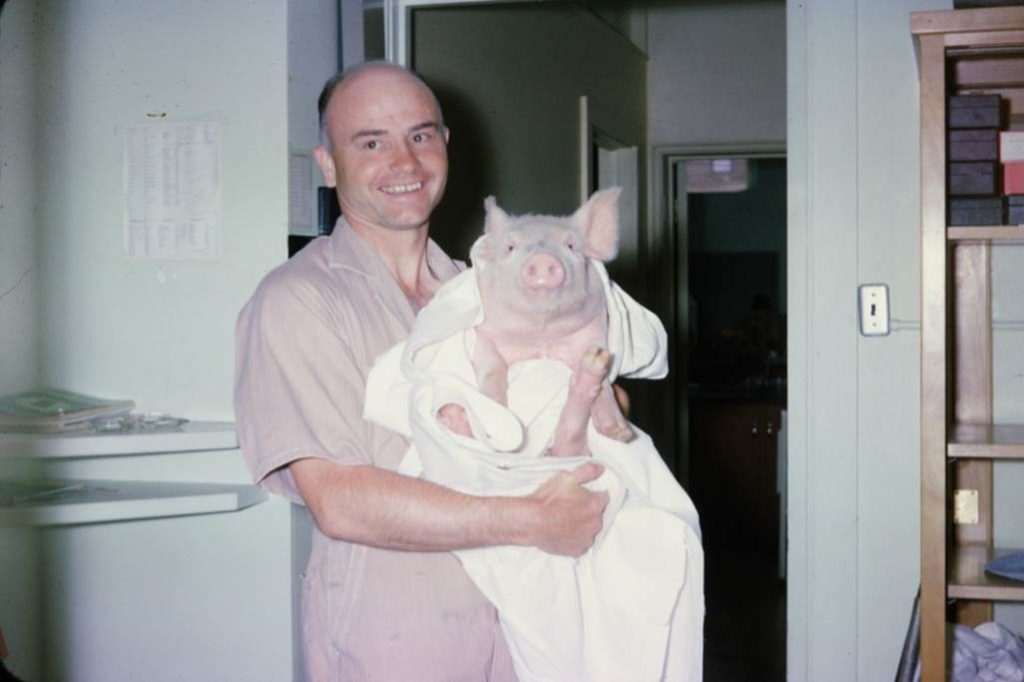CVMBS Amazing Alumni: Meet Richard St. Clair
by CSU MarComm Staff | August 7, 2017 4:13 PM

Above: Richard St. Clair in his tissue culture lab, 1995.
Interview by Claire Tucker, College of Veterinary Medicine and Biomedical Sciences Office of Advancement
Richard St. Clair, B.S., Animal Science, ’62; Ph.D. Physiology and Biophysics, ‘65
Richard St. Clair discovered his interest in arteries as a student at Colorado State University working on high mountain disease. He propelled that interest into a decades-long career as a professor in the Wake Forest University School of Medicine, where he conducted some of the seminal research on atherosclerosis until he retired in 2009. St. Clair has spent his career teaching, mentoring, and serving the communities of Wake Forest and CSU.
He came for the sports, stayed for the science
 [1]
[1]“I grew up in Davenport, Iowa, during the 1940s and ’50s. In high school, I was an average student and did not have a great passion for academics. I was much more interested in athletics, especially playing football. Our team won the Iowa State high school football championship for three consecutive years with a 33-0-1 record. I decided to attend Colorado State University for two reasons: They offered me a tuition-and-fees scholarship for football, and I was interested in their animal nutrition program. I had no idea at the time how I would use this background in a future career.
“I found playing football at CSU to be a very different story than my high school experience. We didn’t win a single game in either my junior or senior year. As graduation was approaching in my senior year, and with my not-so-illustrious football career behind me, I was fortunate to get a job working in a research lab directed by Dr. Frank X. Gassner[2], internationally known for his studies on the metabolism of sperm. I spent the spring performing a variety of biochemical assays on bull sperm. Over the semester, I learned that I enjoyed the work and seemed to have some aptitude for it. I also met Dr. Nicholas H. Booth, the dean of the School of Veterinary Medicine, and Dr. M. L. Hopwood of the chemistry department. They asked if I was interested in graduate school, and ultimately offered me an NIH pre-doctoral fellowship that paid $200 a month.
“Dr. Booth, then one of my Ph.D. advisers, had published on high mountain disease in cattle and was interested in the effect of high blood pressure on arteries. I had been reading about atherosclerosis (hardening of the arteries) and that high blood pressure was one of its risk factors. In his studies, Dr. Booth had developed a surgical technique that could be modified to generate high blood pressure in a segment of the aorta in pigs. This led to one of my most embarrassing moments in graduate school. After several times assisting Dr. Booth with the surgery, it was finally my turn to be the surgeon. I made the initial cut in the skin and fainted flat on the floor. It never happened again, but I never lost the reputation of being ‘the queasy one in the lab.’”
Rams romance
“I would be remiss if I didn’t mention my wife Jeannie, as she has been a major part of whatever success I have enjoyed. I met her during our first year at CSU when we were both nominated to run for vice president of the freshman class. It was clear that she was by far the better candidate, having been head girl at East High School in Denver, where she was heavily involved in student council activities. Of course, she won the election in a landslide – even I voted for her! She was an education major so our paths didn’t cross much again until our sophomore year when we went on a date arranged by two of our fraternity and sorority friends. Cupid’s arrow did its work and we were soon ‘pinned’ and then engaged. We got married in June of 1962, shortly after graduation and moved into Aggie Village, which was new at the time. Over the years we have been blessed with two sons, two wonderful daughters-in-law, and eight grandchildren.”
Atherosclerosis: From pigeons to people
“I have spent much of my career studying one disease: atherosclerosis. Atherosclerosis is a process that develops in arteries caused by the influx and retention of cholesterol-containing low-density lipoproteins (LDL), which initiate a chronic inflammatory process that leads to narrowing of arteries with cholesterol-rich atherosclerotic plaques. Eventually, plaques rupture and block blood flow. If this occurs in the coronary arteries, it leads to a heart attack or, in the brain, a stroke. We now know a lot about the pathogenesis of atherosclerosis, but in 1965 when I finished graduate school, the key metabolic processes in the pathogenesis of this disease were yet to be defined. It was an exciting time to be on the cutting edge of this research.
“The major reason I decided to go to Wake Forest, as a post-doctoral fellow and later faculty member, was to work with Drs. Hugh Lofland and Tom Clarkson. They had discovered that White Carneau pigeons developed atherosclerosis naturally and at an accelerated rate with cholesterol feeding, while Show Racer pigeons were resistant. This difference in atherosclerosis was genetically mediated, but how was not clear. Over the years we characterized many of the biochemical, metabolic and pathologic changes associated with the development of atherosclerosis in these pigeon models. When extended into other animal models, such as nonhuman primates, and genetically engineered mouse models, many of the same biochemical and metabolic process were identified.”
Mentor, teacher, adviser
“One of the great privileges of my career has been the mentees and colleagues with whom I have worked over the years. This includes 18 Ph.D. students, six summer medical students, and 14 post-doctoral trainees. I’ve found the most successful students are those that learn early about the importance of keeping up with the literature in their field, and are willing to learn new technologies and change the direction of their research as new findings emerge. I also have learned not to judge people too soon. With few exceptions, regardless of how they began (do you remember your first seminar? I sure remember mine), our students have gone on to successful careers in research in both academic and industrial settings, in medicine as scientists, teachers, and physicians, and as entrepreneurs starting their own companies.
“As I reflect on my career, I know that the excellent foundation I received at CSU prepared me to have the knowledge, experience and confidence to move forward into a satisfying and productive career. I am always proud to say I am a CSU alumnus!”
- [Image]: http://source.colostate.edu/wp-content/uploads/2017/08/Richard_St_Clair2.jpg
- Dr. Frank X. Gassner: http://csu-cvmbs.colostate.edu/Pages/bms-roots-veterinary-teaching.aspx
Source URL: https://source.colostate.edu/cvmbs-amazing-alumni-meet-richard-st-clair/
Copyright ©2024 SOURCE unless otherwise noted.